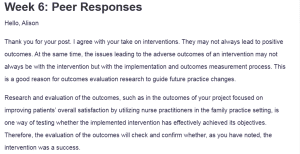Week 6: Peer Responses
Hello, Alison
Thank you for your post. I agree with your take on interventions. They may not always lead to positive outcomes. At the same time, the issues leading to the adverse outcomes of an intervention may not always be with the intervention but with the implementation and outcomes measurement process. This is a good reason for outcomes evaluation research to guide future practice changes: Week 6: Peer Responses.
Research and evaluation of the outcomes, such as in the outcomes of your project focused on improving patients’ overall satisfaction by utilizing nurse practitioners in the family practice setting, is one way of testing whether the implemented intervention has effectively achieved its objectives. Therefore, the evaluation of the outcomes will check and confirm whether, as you have noted, the intervention was a success.
Noting that your project focuses on the overall patient satisfaction using NPs in family practice settings, evaluating and researching the outcomes of this project can help not only determine whether the use of NP in family practice improves patient satisfaction but also help identify new use to combine with NPs in family practice to improve patient satisfaction. Evaluating outcomes can also develop further evidence which can aid policymakers and decision-makers in guiding practice for the benefit of public health (Qoronfleh, 2020).
Additionally, further evaluation of outcomes can help in the personalization of care in nursing to further improve outcomes, including patient practice levels (Spanakis et al., 2020). This can lead to the conclusion that researching and evaluating outcomes is a critical step towards continuous improvement in care settings. This is, as you have noted, the continued improvement in healthcare practices is a result of further exploring previously identified and measured interventions.
References
Qoronfleh, M. W. (2020). Health is a political choice: why conduct healthcare research? Value, importance and outcomes to policy makers. Life Sciences, Society and Policy, 16(1), 1–10. https://doi.org/10.1186/S40504-020-00100-8/
Spanakis, M., Patelarou, A. E., & Patelarou, E. (2020). Nursing Personnel in the Era of Personalized Healthcare in Clinical Practice. Journal of Personalized Medicine 2020, Vol. 10, Page 56, 10(3), 56. https://doi.org/10.3390/JPM10030056
ORDER A PLAGIARISM-FREE PAPER HERE
We’ll write everything from scratch
Question 
PEER RESPONSE 2:
BY: ALISON
Practice changes are typically done based upon research and development in order to work on the common goal of improving outcomes. While interventions may be positive, they may also negatively affect those implementing and those being measured. It is important to research and evaluate whether the outcomes were successful or not, to know whether the intervention needs adjusted or proceeded with. With my topic on improving patient’s overall satisfaction by utilizing nurse practitioners in the family practice setting, while in theory this sounds beneficial and more cost efficient, some patients may not agree with this decision or intervention.

Week 6: Peer Responses
Patient’s perception of healthcare changes based on experience and outcomes (Al-Jabri et. Al., 2021). Collecting qualitative data directly from the patients is my way of measuring the outcomes and patient satisfaction. I will evaluate the roles of outcomes through the questionnaires that are being directly answered by patients. If patients seem overall happy and have an improved satisfaction with their healthcare by seeing a family nurse practitioner, I wish to share that information with other offices and providers in order to create more satisfied patients in other areas.
By improving the overall satisfaction of patients in all care settings, patients are more likely to follow up as they are supposed to. Evaluating outcomes of practice change is an important step in assessing the effectiveness of change. Continued improvements in healthcare can then be made based upon the outcome of the intervention that was previously measured.